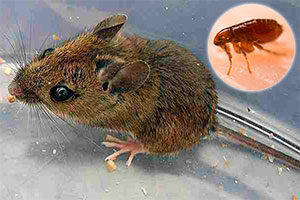Finding evidence of mice in your home can be alarming and frustrating. These small rodents can quickly become a major problem – contaminating food, damaging property, and potentially spreading disease. Whether you’ve spotted mice in your kitchen, attic, bedroom, or just heard suspicious scratching in your walls, this comprehensive guide will help you identify, eliminate, and prevent mice infestations in every area of your home.
Mice can multiply rapidly – just two mice can produce over a thousand offspring in a single year. They carry more than 30 types of diseases and can contaminate surfaces with their droppings, urine, and fur. Understanding how to effectively eliminate these pests from every corner of your home is essential for maintaining a clean, safe living environment.
Quick Picks: How to Get Rid of Mice from Your Home
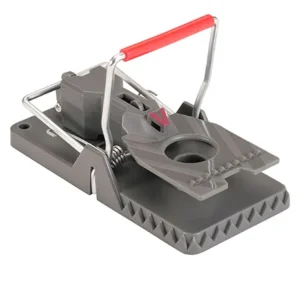
Best Snap Trap
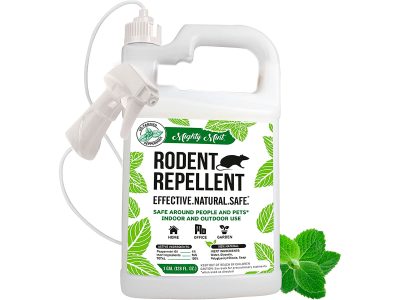
Natural Option
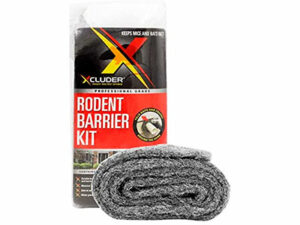
Best Prevention
- Signs You Have a Mouse Infestation
- Understanding Mouse Behavior
- General Mouse Elimination Strategy
- Eliminating Mice in the Attic
- Removing Mice from Walls
- Getting Rid of Mice in the Basement
- Eliminating Mice from the Garage
- Dealing with Mice in Your Kitchen
- Removing Mice from Bedrooms
- Eliminating Mice from Your Yard
- Dealing with Mice in Your Vehicle
- Best Mouse Traps and Baits
- Natural Mouse Repellents
- Cleaning Up After Mice
- Long-Term Prevention Strategies
- When to Call a Professional
- Best Products for Mouse Control
- Frequently Asked Questions
- Conclusion: Creating a Mouse-Free Home
Signs You Have a Mouse Infestation

Before you can effectively tackle a mouse problem, you need to confirm their presence. Here are the telltale signs that mice have invaded your home:
Droppings
Mouse droppings are small (about 1/4 inch), dark, and pellet-shaped. You’ll often find them along walls, in drawers, or around food sources.
Scratching Noises
Hear scratching, scurrying, or squeaking sounds in your walls, ceilings, or floors, especially at night? That’s likely mice moving around.
Nests
Mice build nests from shredded materials like paper, fabric, and insulation. Check hidden areas like storage boxes and inside furniture.
Grease Marks
Mice have oily fur that leaves dark, greasy marks along walls and baseboards where they frequently travel.
You may also notice gnaw marks on food packaging, wood, or electrical wires, and strange pet behavior (like your cat staring at walls or becoming unusually alert).
Understanding Mouse Behavior
To effectively eliminate mice, it helps to understand how they behave:
- Nocturnal activity: Mice are most active at night when humans are sleeping.
- Nesting habits: They prefer dark, secluded areas near food sources, typically within 30-50 feet of where they feed.
- Entry points: Mice can squeeze through gaps as small as 1/4 inch (the size of a pencil) due to their flexible ribs and lack of collarbone.
- Breeding: Female mice can have 5-10 litters per year with 5-12 pups each, creating a rapidly growing infestation if not addressed.
- Social structure: House mice are territorial but live in family groups.
General Mouse Elimination Strategy
Regardless of where mice are hiding in your home, a comprehensive approach to elimination follows these basic steps: Begin by sealing any entry points to prevent mice from entering your home. Next, set up traps in high-traffic areas to catch any existing mice. By following these steps, you’ll learn how to eliminate mice effectively and create an environment less conducive to their return. Make sure to seal any entry points to prevent further infestations, as mice can squeeze through surprisingly small gaps. Additionally, utilizing the best mouse traps for home use can significantly increase your chances of successful removal. Regularly inspect and replenish bait to maintain an effective control strategy.
Remove clutter, food sources, and nesting materials to make your home less attractive to mice.
Inspect your home thoroughly and seal all potential entry points with steel wool, caulk, or specialized barriers.
Place traps in strategic locations where mouse activity has been observed.
Natural or commercial repellents can help drive mice away from specific areas.
Clean and disinfect areas where mice have been to eliminate disease risk.
Once mice are eliminated, take steps to prevent future infestations.
Eliminating Mice in the Attic
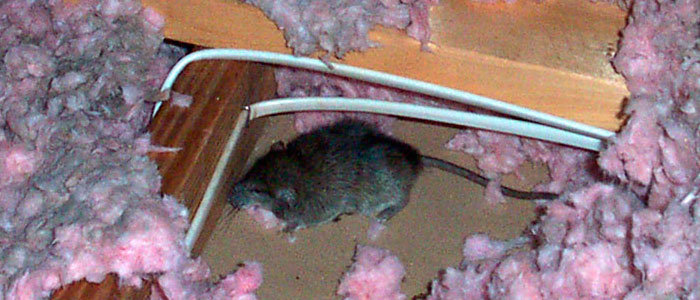
Attics are particularly attractive to mice due to their warmth, isolation, and abundance of nesting materials like insulation. The fluffy texture of blown-in insulation makes it especially appealing to mice looking to escape harsh outdoor conditions.
- Seal all holes and cracks: Carefully inspect your attic for gaps around windows, vents, pipes, and the roof line. Remember, mice can enter through holes as small as a quarter inch.
- Set appropriate traps: Place multiple traps along walls and joists where mice typically travel. Bait them with peanut butter for best results.
- Ventilate the space: Before cleaning, open windows or vents to air out the attic to reduce airborne pathogens.
- Protect yourself: Wear a HEPA filter mask and gloves when cleaning mouse-contaminated areas to prevent exposure to harmful bacteria and viruses.
- Disinfect thoroughly: Use a 1:10 bleach-to-water solution to sanitize areas where mice have been.
- Consider changing insulation: If insulation is heavily infested, consider replacing it with less mice-friendly materials like foam insulation.
Removing Mice from Walls
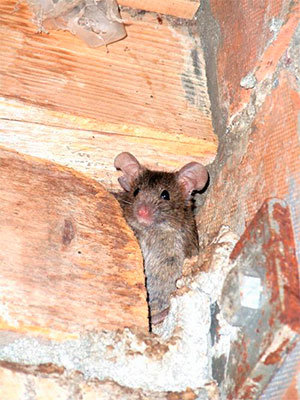
The space between walls provides mice with an ideal protected pathway throughout your home. Dealing with mice in walls requires special techniques since you can’t directly access them.
- Identify wall activity: Listen for scratching and squeaking sounds to locate where mice are active. You might notice most activity at night when mice are most active.
- Create access points: Drill small (nickel-sized) holes a few inches above the floor line where you’ve heard mice. This provides a way to bait and trap them.
- Use the box trap method: Cut a hole in a cardboard box that matches the hole in your wall. Place a baited trap inside the box and position it so the holes align. Cover with clear cellophane to monitor without disturbing the setup.
- Try repellents: Insert cotton balls soaked with peppermint oil into wall openings to drive mice out to areas where you can trap them.
- Seal after elimination: Once you’re confident the mice are gone, patch all holes with steel wool and sealant to prevent re-entry.
Getting Rid of Mice in the Basement
Basements often serve as the initial entry point for mice into your home. From there, they can spread to other areas of your house.
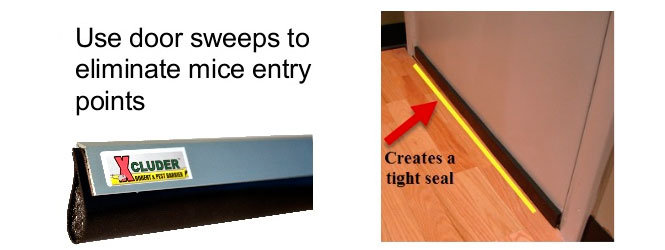
- Clean thoroughly: Remove clutter, debris, and potential nesting materials from your basement. Organize stored items on shelves rather than directly on the floor.
- Inspect and seal entry points: Check for cracks in the foundation, gaps around pipes, and openings along the basement windows and doors. Seal these with concrete patch, steel wool, or caulk.
- Install door sweeps: Put weather stripping on basement doors to prevent mice from accessing the rest of your home.
- Set multiple traps: Place traps along walls where mice typically travel. Use plenty of traps and check them daily.
- Address moisture issues: Fix any leaks or standing water problems, as mice are attracted to water sources.
Eliminating Mice from the Garage
Garages often contain many hiding spots and potential food sources for mice, making them a common infestation site. Cluttered garages with tools, boxes, and storage items provide perfect hiding places for mice.

- Organize and declutter: Remove unnecessary items, organize boxes off the floor, and reduce potential hiding spots.
- Eliminate food sources: Store pet food, bird seed, and other potential food sources in sealed metal or glass containers.
- Check weather stripping: Ensure the garage door has intact weather stripping with no gaps that mice could exploit.
- Seal access points: Inspect walls, the foundation, and roof line for holes. Pay special attention to areas around pipes, vents, and cables entering the garage.
- Set appropriate traps: Place snap traps or live traps along walls and in corners where mouse activity has been observed.
Mice lack a collarbone and can squeeze through holes as small as 1/4 inch in diameter. Fill all openings with strong, rust-resistant materials since mice can chew through caulk and foam.
Dealing with Mice in Your Kitchen
Kitchens are prime targets for mice due to the abundant food sources. Finding evidence of mice in your food preparation areas can be particularly distressing.
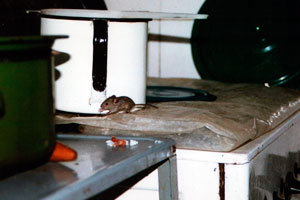
- Keep it clean: Wipe down counters, clean dishes immediately, sweep floors regularly, and don’t leave food out overnight.
- Store food properly: Transfer all grains, cereals, and other pantry items to airtight glass or metal containers that mice can’t chew through.
- Check under appliances: Mice often hide under and behind refrigerators, stoves, and dishwashers. Clean these areas thoroughly and set traps nearby.
- Inspect cabinets: Check for holes in the back of cabinets, especially where pipes enter. Seal these with steel wool.
- Set multiple traps: Place traps along cabinet bases, behind appliances, and in corners where mice travel.
Mice have a keen sense of smell and can detect human scent on traps. Wear gloves when setting traps to increase your chances of success.
Removing Mice from Bedrooms
Finding evidence of mice in your bedroom can be particularly disturbing, as this is your most personal space. The thought of mice crawling on your bed while you sleep is enough motivation to take immediate action.
- Remove attractants: Don’t eat in bed or leave food in your bedroom. Even small crumbs can attract mice.
- Check for entry points: Inspect baseboards, closets, and areas where pipes or cables enter the room for potential mouse access points.
- Clean thoroughly: Vacuum and clean regularly, paying special attention to areas under the bed and in closets.
- Use natural repellents around the bed: Place cotton balls soaked in peppermint oil, cedar shavings, or cloves around your bedroom to deter mice.
- Consider getting a cat: Cats are natural predators, and even their scent can deter mice from entering your bedroom.
Eliminating Mice from Your Yard
Addressing mice in your yard is an important step in preventing them from entering your home. Field mice often live outdoors before finding their way inside.

- Remove debris and clutter: Clear away piles of leaves, wood, and other materials where mice can hide.
- Maintain your lawn: Keep grass trimmed short and prune bushes and trees, especially those close to your home.
- Create a barrier: Consider installing a perimeter of gravel or stone around your foundation as mice avoid crossing open, exposed areas.
- Use outdoor traps: Place weather-resistant traps in areas where you’ve seen mouse activity.
- Consider natural repellent plants: Plant mint, lavender, or sage around your property, as these strong-smelling plants can deter mice.
Dealing with Mice in Your Vehicle
Finding mice in your car can be more than just disturbing—it can lead to expensive damage. Mice are attracted to vehicles for the same reasons they enter homes: warmth, shelter, and in some cases, food remnants. The confined space of a vehicle with its many wires, upholstery, and insulation creates a perfect environment for mice to wreak havoc.

Prevention Strategies for Vehicles
- Keep it clean: Remove all food wrappers, crumbs, and trash from your vehicle. Even small food particles can attract mice.
- Strategic parking: Avoid parking near tall grass, woodpiles, or other areas where mice typically live. Park on gravel or pavement rather than grass or dirt when possible.
- Seal entry points: Use wire mesh to cover potential entry points like vents, openings around cables, and areas near foot pedals.
- Regular use: Drive your vehicle regularly. Cars that sit unused for long periods are more likely to become home to rodents.
- Open the hood: When a vehicle is stored, consider leaving the hood slightly open if it’s in a secure location. This reduces the darkness and warmth that attracts mice.
Effective Mouse Repellents for Cars
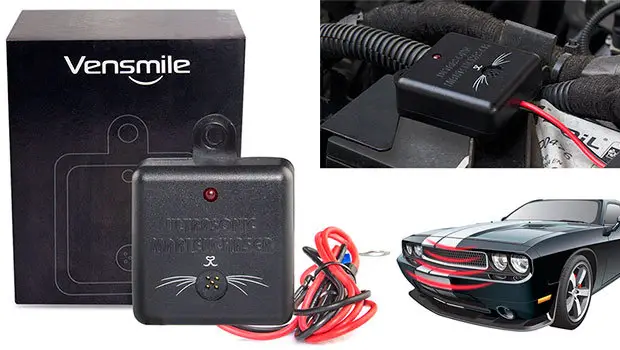
Several repellent options are particularly effective for vehicles:
- Peppermint oil: Place cotton balls soaked in peppermint oil in strategic locations throughout your vehicle, including under the hood. Refresh every few days.
- Commercial repellent pouches: Products containing mint oils come in convenient pouches that can be placed in your car’s interior and engine compartment.
- Ultrasonic repellers: Special automotive ultrasonic devices can be installed in your engine compartment to emit high-frequency sounds that deter mice without being audible to humans.
If You Find a Mouse in Your Car
- Set appropriate traps: Place snap traps on top of tires where mice climb up and inside the vehicle in areas where activity has been noticed.
- Check for nests: Thoroughly inspect your engine compartment, air filters, and cabin air filter for nesting materials.
- Clean properly: If you find droppings or a dead mouse, use gloves and a bleach solution (1.5 cups of bleach per gallon of water) to sanitize the area. Double-bag any mouse remains before disposal.
- Inspect for damage: Check wiring and hoses for signs of chewing. Consider having a mechanic inspect your vehicle if you suspect damage.
For vehicles that are stored long-term or used seasonally, implement a comprehensive mouse prevention plan before storage to avoid returning to an unpleasant surprise and potentially costly repairs.
Best Mouse Traps and Baits
Choosing the right traps and baits is crucial for mouse control success. Here are the most effective options:
Types of Traps
| Trap Type | Pros | Cons | Best For |
|---|---|---|---|
| Snap Traps |
|
|
Most indoor locations, especially where there are clear mouse pathways |
| Live Catch Traps |
|
|
Those who prefer not to kill mice; homes with children or sensitive pets |
| Electronic Traps |
|
|
Severe infestations; those who don’t want to see dead mice |
| Glue Traps |
|
|
Last resort for difficult infestations |
Best Baits for Mouse Traps

The right bait can significantly increase your trap success rate. Here are the most effective options:
- Peanut butter: The strong smell attracts mice, and its sticky texture forces mice to work at it, increasing trigger chances.
- Chocolate: Mice love sweet foods and will be drawn to chocolate pieces.
- Bacon: The strong smell of cooked bacon (cooled) is irresistible to mice.
- Bird seed or pet food: Familiar foods that mice are likely already eating in your home.
- Dental floss or string: Not food, but mice collect nesting materials and may be attracted to these items.
Natural Mouse Repellents

If you prefer natural solutions or want to supplement your trapping efforts, these repellents can help deter mice:
Peppermint Oil
Mice hate the strong smell. Soak cotton balls and place them in mouse-prone areas. Reapply every few days. In addition to using cotton balls, it’s important to keep your space clean and free from food scraps that might attract mice. If you do encounter droppings, it’s crucial to know how to remove mouse droppings safely to prevent health risks. Wearing gloves and a mask, carefully clean up the droppings with a disinfectant to ensure your environment remains protected.
Cat Litter
Used cat litter placed strategically signals to mice that a predator is nearby, causing them to avoid the area.
Cedar
Cedar shavings or blocks placed in drawers and closets emit a scent that repels mice naturally.
Cloves & Cayenne
Mice dislike these strong spices. Sprinkle them in problem areas to create a natural barrier.
Cleaning Up After Mice
Proper cleaning after a mouse infestation is crucial to protect your health. Mouse droppings, urine, and nesting materials can harbor dangerous diseases, including hantavirus.
- Ventilate first: Open windows and doors for at least 30 minutes before cleaning to allow fresh air to circulate.
- Wear protective gear: Always use rubber gloves and an N95 respirator mask (or P100 if available).
- Never vacuum or sweep: This can aerosolize viral particles. Instead, spray the area with disinfectant first.
- Use proper disinfectant: Mix 1 part bleach with 10 parts water. Spray contaminated areas thoroughly and let soak for 5-10 minutes.
- Use disposable materials: Clean with paper towels and dispose of them in sealed bags immediately.
- Double-bag all waste: Place all cleaning materials and mouse remains in sealed plastic bags for disposal.
- Clean yourself thoroughly: Wash hands and exposed clothing in hot water and detergent after cleaning.
Long-Term Prevention Strategies
Once you’ve eliminated mice from your home, implement these strategies to prevent future infestations: Seal any gaps or cracks in your walls, floors, and foundations to deny entry points for mice. Additionally, maintain a clean environment by storing food in airtight containers and regularly disposing of garbage. For those wondering how to eliminate field mice specifically, consider using traps or natural repellent methods to effectively manage their presence. Seal any entry points, such as gaps around doors and windows, to keep mice from getting inside. Additionally, consider utilizing homemade solutions for mice removal, which can be both effective and environmentally friendly. Regularly clean up food debris and clutter to eliminate potential nesting sites and food sources for any stray rodents.
- Regular inspections: Check your home’s exterior and interior seasonally for new gaps or entry points. Be especially vigilant in fall when mice seek warmth.
- Maintain cleanliness: Keep food in sealed containers, clean up crumbs promptly, and don’t leave dirty dishes overnight.
- Reduce outdoor attractants: Keep garbage in sealed containers, pick up fallen fruit from trees, and maintain bird feeders away from the house.
- Trim vegetation: Keep bushes trimmed away from your home’s foundation and cut tall grass regularly.
- Use deterrents strategically: Place natural repellents in problem areas seasonally, especially before winter when mice seek indoor shelter.
Mouse infestations often worsen in fall and winter as mice seek warm shelter. Be extra vigilant during these seasons by increasing inspections and preventative measures.
When to Call a Professional
While many mouse problems can be handled DIY-style, sometimes professional help is necessary. Consider contacting a pest control expert if:
- Your infestation persists despite multiple elimination attempts
- You cannot locate the entry points mice are using
- You have health concerns about handling mouse cleanup
- The infestation is extensive (you’re seeing multiple mice daily)
- You have mice in difficult-to-access areas like HVAC systems
- You have pregnant women, infants, elderly, or immunocompromised individuals in your home
Professional exterminators have specialized tools and knowledge to handle severe infestations safely and effectively. They can also provide tailored advice for your specific home and situation.
Best Products for Mouse Control
Victor M393SSR Humane Mouse Traps
Best Value PackHow Does It Work
How to Use
- Set the trap with one simple click
- Bait with peanut butter or other high-protein food
- Place along walls where mouse activity has been observed
- After catching a mouse, simply click to release for disposal
- Clean with mild disinfectant and reset as needed
- Economical 6-pack for addressing larger infestations
- Easy one-click set and release mechanism
- No chemicals, safe to use around children and pets
- Reusable design for long-term rodent management
- Large trigger pedal for reliable activation
- Requires handling of dead mice
- May potentially harm pets if triggered accidentally
- Not enclosed, so caught mice are visible
- Needs regular checking and resetting
Mighty Mint Rodent Repellent
Natural OptionHow Does It Work
How to Use
- Shake well before using
- Spray liberally along baseboards, in corners, around entry points, and other areas where mice activity is suspected
- Apply every 2-3 days initially, then weekly for maintenance
- For severe infestations, increase application frequency
- Can be sprayed directly onto cotton balls for placement in hard-to-reach areas
- Natural formula without harsh chemicals
- Pleasant mint scent for humans
- Safe for use around food preparation areas
- No need to handle dead mice
- Extra-concentrated for long-lasting protection
- Requires regular reapplication
- May not be effective for severe infestations when used alone
- Strong scent may be overwhelming in enclosed spaces
- Less effective in areas with competing strong odors
Xcluder Rodent Barrier Kit
Best PreventionHow Does It Work
How to Use
- Identify all gaps, cracks, and potential entry points around your home
- Clean the area thoroughly before application
- Cut the Xcluder material to slightly larger than the gap size
- Use the included tools to stuff the material firmly into gaps and cracks
- For larger openings, place backing material first, then add Xcluder
- Non-toxic and non-corrosive
- Permanent solution that won't rust or degrade
- Includes all necessary tools for installation
- Works on gaps of various sizes
- Made in the USA
- Higher initial cost than traditional steel wool
- Requires proper installation for effectiveness
- May be visible in certain applications
- May require additional sealant for a finished appearance
Frequently Asked Questions
Do mice crawl on sleeping people?
Yes, mice may crawl on sleeping people, especially if your bed provides a pathway to a food source or nesting material. Mice are typically fearful of humans but will take risks when food is scarce or when seeking warmth and shelter.
To prevent this disturbing possibility, keep food out of the bedroom, ensure your bedroom is sealed against entry points, and consider using natural repellents like peppermint oil around your bed.
How do I know if I have mice or rats?
Mice and rats leave different evidence:
- Droppings: Mouse droppings are small (1/4 inch) with pointed ends, while rat droppings are larger (3/4 inch) with blunt ends.
- Size: Mice are small (2-4 inches body length) with large ears, while rats are larger (7-10 inches) with smaller ears relative to their size.
- Sounds: Mice make high-pitched squeaking sounds, while rats make deeper grunting noises.
- Damage: Rats cause larger, more destructive gnaw marks than mice.
Will mice leave on their own?
Mice will rarely leave on their own once they’ve established a nest in your home. They’ve found shelter, warmth, and likely food sources, so they have no incentive to leave voluntarily.
Only significant environmental changes like removal of all food sources, elimination of nesting sites, introduction of predators, or use of strong repellents might drive them out – but active removal methods are usually necessary.
How many mice typically live together?
A typical house mouse colony consists of one dominant male, several females, and their young. In ideal conditions with abundant food, a single breeding pair can grow to a colony of 30-50 mice within a few months.
If you see one mouse, there are almost certainly more hiding nearby. This is why comprehensive mouse control is important – addressing a single mouse won’t solve the underlying infestation.
Can mice climb walls and ceilings?
Yes, mice are excellent climbers and can scale vertical walls with textured surfaces like brick, wood, or drywall. They can also travel upside-down along pipes and rough ceiling surfaces.
Their ability to climb and squeeze through tiny openings means no area of your home is inaccessible to them. This climbing ability must be considered when planning exclusion strategies.
Do electronic ultrasonic repellents work against mice?
Scientific evidence for ultrasonic repellers is mixed at best. They may temporarily deter mice, but rodents typically become habituated to the sounds after a short period.
Ultrasonic devices should only be used as a supplementary method alongside proven control techniques like trapping and exclusion, not as your primary mouse control strategy.
Conclusion: Creating a Mouse-Free Home
Eliminating mice from your home requires a comprehensive approach that addresses all aspects of the problem – from entry points and attractants to active removal and thorough cleaning. By understanding mouse behavior and implementing the strategies outlined in this guide, you can reclaim your home from these unwanted invaders.
Remember that persistence is key. A single missed entry point or food source can allow mice to return. Regular monitoring and maintenance of your mouse prevention system will ensure long-term success.
For severe or persistent infestations, don’t hesitate to contact professional pest control services. The investment in professional help can save you time, frustration, and potentially protect your family’s health.
With diligence and the right techniques, you can create and maintain a mouse-free home environment for years to come.
About the author
Inga Cryton is the researcher and creator behind PestKill.org, a site dedicated to providing well-researched pest management information. Through thorough research and consultation of reliable sources, she shares effective and environmentally responsible pest control strategies. Have a question or topic suggestion? Get in touch.
